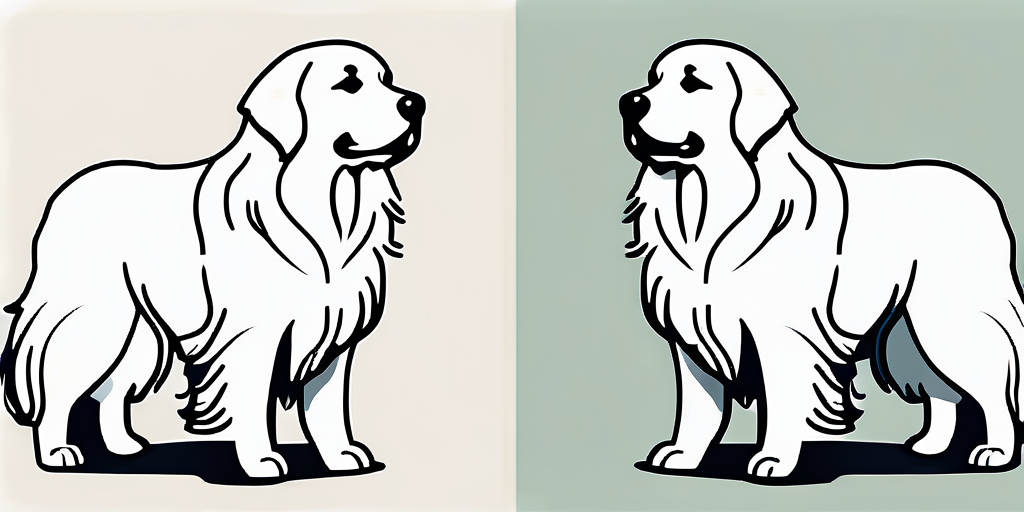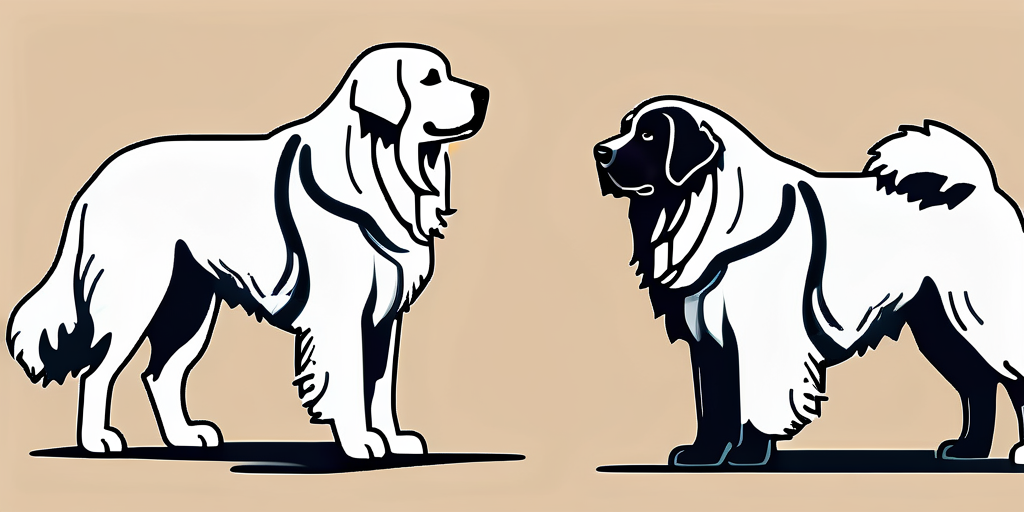The Great Pyrenees and the Newfoundland are two majestic dog breeds that capture the hearts of dog lovers worldwide. Both breeds possess unique characteristics and qualities, making them a popular choice for families and individuals seeking a loyal and gentle companion. In this article, we will delve into the various aspects of these breeds, including their physical characteristics, temperament, health, training needs, and more. By the end, you’ll have a better understanding of these magnificent breeds, enabling you to make an informed decision if you’re considering welcoming one into your home.
Understanding the Breeds: An Introduction
Before we delve into the specific traits of the Great Pyrenees and the Newfoundland, let’s take a moment to introduce these two incredible breeds.
Both the Great Pyrenees and the Newfoundland belong to the working group of dog breeds, known for their intelligence, strength, and versatility. These breeds have a long history of serving alongside humans in various capacities, showcasing their loyalty and dedication.
The Great Pyrenees: A Brief Overview
The Great Pyrenees, also known as the Pyrenean Mountain Dog or the Patou, has a long and rich history. Originally bred to guard livestock in the Pyrenees Mountains of France and Spain, these dogs are renowned for their protective instincts and loyalty.
In addition to their guarding abilities, Great Pyrenees are also known for their gentle and affectionate nature towards their families. Despite their large size, they are known to be gentle giants, especially with children and other pets.
Physically, Great Pyrenees are large, majestic animals with a dense double coat that offers protection from both cold and heat. They have a regal appearance, with a proud posture and an elegant stride. Their thick fur requires regular grooming to prevent matting and to keep them comfortable in all seasons.
The Newfoundland: A Brief Overview
The Newfoundland, often referred to as the “Gentle Giant,” originated from the Canadian province of Newfoundland and Labrador. These dogs were initially bred as working dogs, assisting fishermen by hauling nets and rescuing people from water.
Known for their exceptional swimming abilities, Newfoundlands have webbed feet that aid them in navigating water with ease. Their muscular build and strong, powerful limbs make them well-suited for tasks that require strength and endurance.
Newfoundlands are not only skilled working dogs but also beloved family pets. They are known for their sweet and gentle temperament, making them excellent companions for families of all sizes. Their thick, water-resistant coat requires regular maintenance to prevent tangling and to keep them looking their best.
Physical Characteristics Comparison
When comparing the physical characteristics of the Great Pyrenees and the Newfoundland, several notable differences and similarities emerge.
Understanding the unique traits of these majestic breeds can provide valuable insights for potential owners seeking a furry companion that fits their lifestyle and preferences.
Size and Weight: Great Pyrenees vs Newfoundland
Size-wise, both breeds are impressively large, but the Newfoundland typically outweighs the Great Pyrenees. Male Newfoundlands can weigh between 130 and 150 pounds, while male Great Pyrenees range from 100 to 120 pounds. Females of both breeds are slightly smaller. Despite their substantial size, both breeds are known for their gentle and affectionate nature, making them excellent family pets.
Coat and Colors: A Visual Comparison
The Great Pyrenees and the Newfoundland both have thick, double coats that require regular grooming. The Great Pyrenees’ coat is predominantly white, with potential markings of gray, badger, or tan, adding to their striking appearance. In contrast, Newfoundlands come in various colors, including black, brown, gray, and Landseer (black and white), showcasing their versatility in coat shades.
Furthermore, the double coats of these breeds serve as protection against harsh weather conditions, with their dense fur providing insulation in colder climates and UV protection in sunnier regions.
Temperament and Personality Traits
Beneath their majestic appearance, both the Great Pyrenees and the Newfoundland possess unique temperament and personality traits that contribute to their appeal as beloved family pets.

Understanding the intricacies of their temperaments can help potential owners make informed decisions when choosing a canine companion.
The Gentle Giant: Great Pyrenees Temperament
Great Pyrenees are renowned for their gentle and patient nature. They are typically calm, confident, and intelligent, making them excellent companions. While affectionate with their families, they can be somewhat reserved with strangers, emphasizing their protective instincts.
Originating from the mountainous regions of France and Spain, Great Pyrenees were bred to guard livestock, a role that has influenced their temperament. Their independent nature and strong-willed personality require consistent training and socialization from an early age.
With proper socialization and training, Great Pyrenees can coexist harmoniously with other animals and children, establishing their role as devoted and watchful guardians of their pack.
The Gentleman of Dogs: Newfoundland Temperament
Newfoundlands embody the term “gentle giant” to the fullest. They are gentle, sweet-natured, and patient, making them exceptional companions, especially for families with young children. These dogs are known for their love of water and their natural affinity for swimming.
Originally bred as working dogs for fishermen in Newfoundland, Canada, Newfoundlands have a strong work ethic and are eager to please their owners. Their calm demeanor and affectionate nature make them well-suited for therapy work and service roles.
Additionally, Newfoundlands are known for their intelligence and trainability. They excel in activities such as water rescue, obedience, and therapy work, further solidifying their reputation as loving and versatile companions.
Health and Lifespan: A Comparative Analysis
When considering the health and lifespan of any dog breed, it’s essential to be aware of potential breed-specific health issues. Both the Great Pyrenees and the Newfoundland are generally robust breeds, but they may be prone to specific conditions.
Understanding the common health issues in these breeds can help owners be proactive in managing their pets’ well-being. Regular veterinary check-ups, a balanced diet, and sufficient exercise are crucial for maintaining the health and longevity of Great Pyrenees and Newfoundlands.
Common Health Issues in Great Pyrenees
- Canine hip dysplasia
- Elbow dysplasia
- Heart conditions (including mitral valve disease)
- Hypothyroidism
- Progressive retinal atrophy (PRA)
Great Pyrenees are known for their gentle and protective nature, but they are also susceptible to certain genetic health issues. Mitral valve disease, a common heart condition in this breed, can lead to heart failure if left untreated. Regular monitoring of heart health through diagnostic tests can help detect any abnormalities early on.
Common Health Issues in Newfoundlands
- Canine hip dysplasia
- Elbow dysplasia
- Heart conditions (including subvalvular aortic stenosis)
- Cystinuria
- Gastric dilatation-volvulus (bloat)
Newfoundlands, with their sweet and gentle temperament, are prone to certain health conditions that owners should be vigilant about. Cystinuria, a genetic disorder that affects kidney function, can lead to the formation of urinary stones. A specialized diet and adequate hydration can help manage this condition and reduce the risk of complications.
Training and Exercise Needs
Proper training and exercise are key to raising a well-behaved and balanced dog. Both the Great Pyrenees and the Newfoundland require consistent training and regular exercise to thrive.

When it comes to training a Great Pyrenees, there are a few things to expect. First and foremost, it’s important to start training your Great Pyrenees early, as they can be independent thinkers. This means that they may not always follow commands blindly and may need some extra patience and persistence during the training process. However, with the right approach, they can become obedient and well-behaved companions.
- Start training your Great Pyrenees early, as they can be independent thinkers.
- Use positive reinforcement techniques, such as treats and praise, to motivate your dog.
- Provide consistent socialization from an early age to ensure they are comfortable and well-behaved around other animals and people.
- Focus on leash training to manage their strong protective instincts.
- Enroll in obedience classes to develop and strengthen their training skills.
On the other hand, training a Newfoundland comes with its own set of expectations. Newfoundland dogs are known for their intelligence and eagerness to please, which makes them highly trainable. They respond well to positive reinforcement training methods, such as rewards and praise. This means that you can use treats and kind words to motivate and encourage them during the training process.
- Begin training your Newfoundland puppy as soon as you bring them home to establish good habits.
- Since Newfoundland dogs are intelligent and eager to please, they respond well to positive reinforcement training methods.
- Provide them with ample socialization opportunities to ensure they grow into well-rounded dogs.
- Include swimming exercises as part of their physical activity, as they have a natural affinity for water.
- Enroll in obedience or specialized training classes to further develop their skills and potential.
When it comes to training both the Great Pyrenees and the Newfoundland, consistency and patience are key. It’s important to establish a routine and stick to it, providing them with clear boundaries and expectations. Remember, training is an ongoing process, and it’s important to continue reinforcing their training throughout their lives.
In conclusion, the Great Pyrenees and the Newfoundland are both extraordinary breeds that possess distinctive qualities and characteristics. While the Great Pyrenees is known for its regal and protective nature, the Newfoundland is celebrated for its gentle and friendly demeanor. When choosing between these majestic breeds, consider your lifestyle, preferences, and commitment to providing them with the care and attention they need. With the right environment, both the Great Pyrenees and the Newfoundland can bring joy and companionship to your life for many years to come.
Discover More with BreedRead
Deciding between a Great Pyrenees and a Newfoundland is just the beginning of your journey with these majestic breeds. At BreedRead.com, we provide you with all the resources you need to understand and care for your chosen companion. From in-depth breed comparisons to tailored care guides, our platform is dedicated to helping you make informed decisions and nurturing a healthy, happy relationship with your dog. Don’t miss out on expert insights and tips—subscribe to our free newsletter today and join a community passionate about the well-being of our canine friends.

